desperate for bootleg korean kaze to ki no uta i scan stuff sometimes
Don't wanna be here? Send us removal request.
Photo

Ashita no K-ko chan no. 1 – Takemiya Keiko
Ashita no K-ko chan (obviously a parody of Ashita no Joe) is series of short autobiographical comics Takemiya Keiko wrote for JUNE magazine. Some of the strips are quite funny, and a lot of them deal with how Takemiya came to draw manga and became interested in what would later come to be called “shonen-ai”.
It was collected into a tankobon for the first time by eBookJapan!
99 notes
·
View notes
Text
Reposting my old tweet as I'm still hunting down the elusive Korean yuri kazeki bootlegs. Hoping the Tumblr crowd is interested in helping with the search. One reblog for genderbent British kazeki is one vote for a better tomorrow. CLICK HERE FOR DETAILS

34 notes
·
View notes
Text

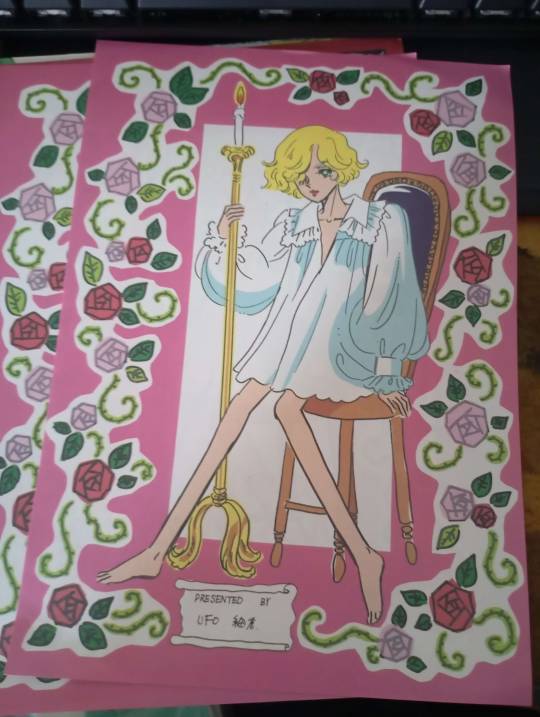
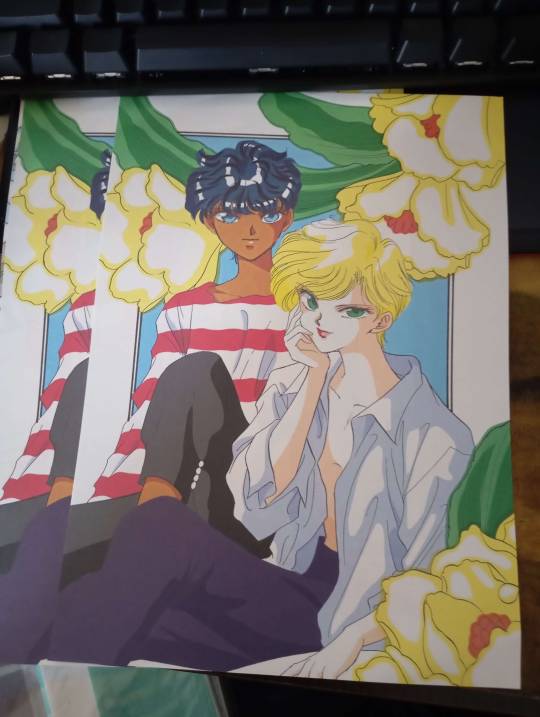
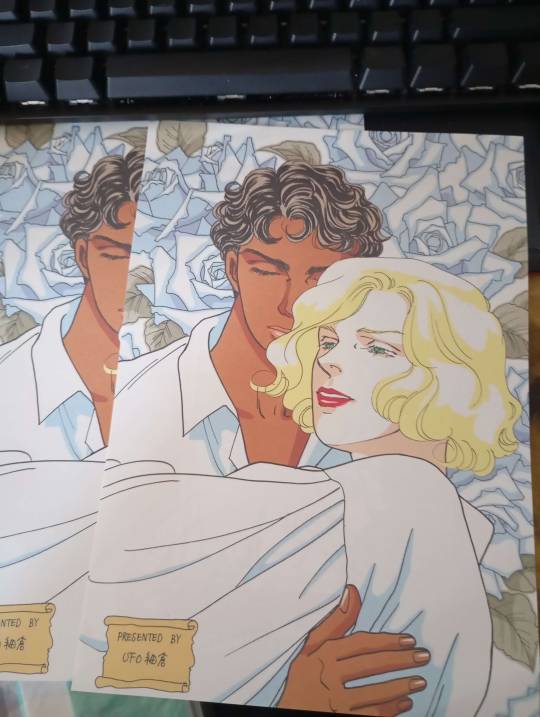
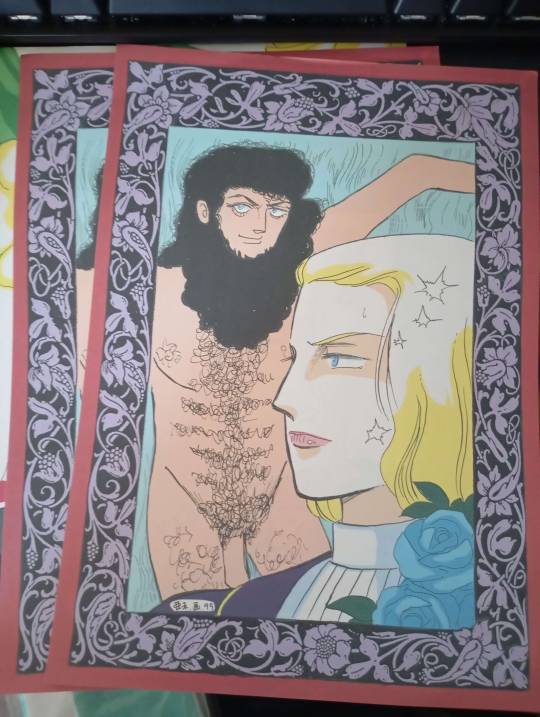
Got a bunch of manga related stuff in the mail including this doujin on kazeki that came bundled with a bunch of illustrations. Absolutely in love with these.
Apologies for the Bonnard bonner if I don't tag this properly.
2 notes
·
View notes
Text
I've been dipping my toes in the English-language side of manga fandom, specifically the collector's fandom, and man, it's about as dire as it's always been, huh? Publishers putting out expensive hardcover editions for collectors which are typically designed to go print after the first run, while never releasing the same title in cheap, small softcovers, will only work to atrophy the audience. Manga is mass populist media! They're pulp! Nothing outside of 1. niche artists with a very limited target audience (I'm talking 60s Garo-level niche, not Rose of Versailles ffs) and 2. popular series that already had a good run in paperback should be getting exclusive deluxe complete editions for the collector's market. It's like these publishers want the market to fail in the long run in return for bigger markups now now now.
But I've ranted about this before and it's pretty obvious both the fandom and the publishers disagree. Fans like big format hardcovers although they're heavy and expensive and a bitch to read and mostly exist to look pretty on shelves.
41 notes
·
View notes
Text
#1 Yoshida Akimi's 1979 Puff Interview
Please check the interviews masterpost here.
An Encounter with A Little Devil After You Pull An All-Nighter
June, 1979.
Interview taken when Yoshida-sensei came to Shogakukan to submit her manuscripts for California Monogatari, her first serialization. Back then, manga artists brought their drafts to the company themselves. In “Puff” where the interview was first published, the impression she left is “a playful petite girl who makes a lot of facial expressions”.
First published in September 1979 issue of Puff. Interviewer: Gouda Hitoshi (Seisuisha)
— When did you start drawing manga?
Yoshida: When I started junior college.
— Oh, that’s later than I thought.
Yoshida: Hehehe, you think?
— But you must have drawn some before that too.
Yoshida: You’re right. I was doodling the teacher’s face on my notepad. I quite liked stuff like that. I did it a lot ever since I was a child.
— What made you take drawing seriously after you started junior college?
Yoshida: Hmm, I never noticed a specific “instigator”.
— Maybe it was because you had too much free time in junior college?
Yoshida: Haha, yes. I can agree to that. I also had nothing else to do (laughs).
— What was your style like at first?
Yoshida: By “at first,” do you mean before I got published? I had only drawn one manga back then. Ah no, maybe two. Right, I submitted one of them, and it won an award or something. And as different editors were looking over it, I drew another one… Then I made my debut.
— When you say you submitted it, do you mean BetsuComi (1) Manga Academy?
Yoshida: No, it was for ShuuComi (2). For the “Manga Research Students”.
— Oh, how did that happen then?
Yoshida: Well, it happened to have the shortest deadline (laughs).
— Can you give us more details on what happened after that until you made your debut?
Yoshida: Long story short, I submitted my first work to the contest, and then they told me to come to Shogakukan. When I did, they stood me up (laughs). That kind of pissed me off (laughs). When they were looking over my submission, they pestered me to draw another one. Truth be told, I almost didn’t have enough credits at school and I was in no position to draw manga… It was extremely hard. But I got paid in the end, I won the Research Award.
— Oh, so an award was involved.
Yoshida: It’s not just any award, it’s the Research Award (laughs). Which means that unless you draw manga, you don’t get to have the money. At first. It annoyed me so much (laughs). “All right, I’ll draw. All I need is to draw, right?” (laughs). That’s how I drew another manga, and then I was out in the world. At the outset, I was having quite a hard time. I was so busy, how was I supposed to draw manga (laughs)!
— I’m almost jealous of how you didn’t have to stay at the bottom of the ladder to waste away.
Yoshida: I get that a lot. But lately, everyone seems to be sharing the feeling. No one who debuted around the same time as me went through much hardship.
— Did you specifically study illustration?
Yoshida: No, not at all.
— So, it’s your innate talent.
Yoshida: Oh no, it’s nothing of the sort.
— The body build of Heath and everyone around him is very natural. Compared to other shoujo manga, they feel more “physical"?... You can almost smell their sweat.
Yoshida: Smell their sweat (laughs). I wonder about that.
— Yoshida-san, your debut was quite shocking.
Yoshida: Huh, was it?
— It felt like an amazing rookie appeared literally out of nowhere.
Yoshida: Ahaha, did I appear out of nowhere (laughs)? But that’s completely different from now. I recently sorted out my manuscripts, and thought to myself, “wow, I have changed!”.
— You did?
Yoshida: I don’t even want to see my old drawings (laughs).
— How did you feel when you were told your debut work was going to be published?
Yoshida: “Ah, is that so? I’ll get some cash.” (laughs)
— Was your debut planned? Like, “if you get a favorable response, the next one is sure to be published”.
Yoshida: They looked at my rough drafts, and told me to use them for the next one, so I should do my best.
— That was relatively easy. Did you get any reactions after your debut?
Yoshida: Let me think… I got a few letters.
— You kept the same characters for your next work, right?
Yoshida: I happened to like them, so I just went ahead and did it. Did the same thing again.
— Will we see Rufus-kun (3) again?
Yoshida: Hmm, my style has changed, so... Well, we’ll see.
— You are being serialized now. Do you still get few fan letters?
Yoshida: Yes, I don’t get that many. I’m sure I’m not popular (laughs).
— Didn’t you get letters saying that Heath’s legs were too short?
Yoshida: Yes, I get those. I will definitely have more (laughs). I get few fan letters already, but more than half of them are about that (laughs).
— Maybe everyone is poisoned by the long legs other artists draw.
Yoshida: But I’m drawing long legs. I believe I’m drawing them longer than needed. I wonder why people tell me that they are short.
— I think you body proportions are well-balanced and great.
Yoshida: In my doodles, the characters have much, much shorter legs. So much like myself (laughs).
— Yes, when you draw those illustrations with the gag touch, the legs get extremely shorter. It feels like they are walking like ducks (laughs).
Yoshida: They have short legs even when I’m not going for the gag effect.
— This might be a too generic question, but were you influenced by anyone?
Yoshida: When I first started drawing manga, which was way in the past, I tried my best trying to draw Iwaneyama Ruriko-san that appears in Tezuka Osamu-sensei’s (4) “The Vampires”.
— Why her?
Yoshida: Because I loved her. There aren’t many women like her. There were lots of characters with big, vertically elongated eyes like Atom Boy. That’s why that was the only kind of thing I could draw, but after trying to draw her, I was able to draw horizontally wide, upward-slanted eyes.
— So, that’s where the roots of your current style lies!
Yoshida: Hehe, I’m not too sure about that, but anyway, I loved “The Vampires”. I was drawing nothing but wolves. This was way back when I was in elementary school.
— It’s got to be Tezuka-san, after all. Did you watch his work on TV?
Yoshida: Yes, you mean his anime and the shows he did for TV, right? They weren't that good.
— Speaking of anime, there’s a part where Tsutsui Kyouichi-kun imitates 009. Was that in “Rakuen no Mannaka” (In the Middle of Heaven)?
Yoshida: Ah, that one?
— After reading that, I was rolling on the floor, laughing for a good hour.
Yoshida: I wonder if the kids today would understand that.
— Maybe they do read that stuff, show knows?
Yoshida: They wouldn’t know what an “accelerator” is. That’s only for old timers (laughs).
— What was the reaction you got from the people close to you about drawing manga?
Yoshida: Like from my friends? Oh, it was terrible. I kept silent about it at first. Then one day, I told a friend that I was drawing manga to see what would happen. When I did, they were so shocked that they almost flied out of the roof (laughs). And when I told them I was drawing shoujo manga, they were totally flabbergasted (laughs hard). I didn’t like that, so I didn’t tell people about it much, but they have found me out recently. They have randomly started to ask me for money (laughs).
— So they think you are profiting from it.
Yoshida: That’s the notion everyone has.
— And your parents?
Yoshida: They have given up on me. As long as I don’t get involved with the police, they are fine with anything I do.
— Don’t they tell you being a manga artist a sort of… a frivolous trade?
Yoshida: Well, maybe I looked so terrible in their eyes already, so they thought I might as well just draw some manga?
— Do you like music?
Yoshida: Yes, I do.
— You have a manga [chapter] titled “Hotel California”. Did you name it so because you are a fan of Eagles (5)?
Yoshida: Ahaha, it’s more like, that one was just laying around, so I went ahead and used it as a name.
— You use Simon & Garfunkel’s (6) songs in the manga though…
Yoshida: True. I might be inclined towards that kind of stuff. It’s also a matter of zeitgeist.
— What about movies?
Yoshida: I like them.
— Is there a director you like in particular?
Yoshida: No, I only like certain actors. Hahaha. Since they are dead, I don’t get to see them in movies recently though.
— Then setting those aside, can you talk about a recent movie you’ve seen?
Yoshida: Big Wednesday! That moved me deeply!
— Wasn’t the ending theme (7) downright ridiculous?
Yoshida: Yeah, I left the theater right away (laughs). I want to go and see the movie again, but I plan to leave my seat the moment that song starts playing (laughs).
— So you do like movies about youth.
Yoshida: You’re right. I’m not good with romance movies.
— What about science-fiction?
Yoshida: I love it! It’s fun!
— What do you think of “2001: A Space Odyssey”?
Yoshida: I’ve seen it. It was shocking.
— First time seeing it?
Yoshida: Yes. I had read the source material before. I found it interesting, so I just had to see the movie and have been waiting for it.
— What else have you seen?
Yoshida: “Looking for Mr. Goodbar” and “Midnight Cowboy”, I guess. I have seen Midnight Cowboy 7 or 8 times already. When I first watched it, I was so shocked, and I watched it about 5 times more, consecutively. I will keep watching it at every chance I get.
— Let’s go back to talking about your work. Can you talk about your Rakuen series?
Yoshida: Drawing that was the easiest. It’s like a first-person novel or a diary. It absolutely has no structure.
— It was also easy and fun to read.
Yoshida: I always had “lightheartedness” in mind as I worked. I took it easy.
— How about daring comedies like “Akuma to Himegimi”? Do you have any plans for drawing something like that again?
Yoshida: I would love to. But I’m too busy with my current serialization, so… I can’t really think of anything else.
— About Tsutsui Kyouichi-kun’s character, can you tell me where it all started?
Yoshida: He is a real person.
— What? (surprised)
Yoshida: I based most of the characters there on real people.
— Ooh, I also know someone who is like him!
Yoshida: Oh (laughs). Who would have thought there would be another guy like him in this world, huh?
— Heath, Eve and Butch have made their first appearance in “Madame Brell no Ningyou” (Madame Brell’s Mermaid). Did you create those three characters before that work? Or did you create them along with the story?
Yoshida: That’s a completely different story than California Monogatari, so it would be fine even if it wasn’t those three. But somehow, I ended up using those three.
— Are those three characters older than that?
Yoshida: No, they’re not. Not that I know of.
— Maybe you at least had the idea about their images before your debut?
Yoshida: No, that’s not true. They just flashed in my mind one day from the doodles I used to draw on straw papers. To think that I would be cooking up ideas for their images from way back then… It’s not something of such a grand scale (laughs).
— From the readers’ side, it feels like a long-waited appearance.
Yoshida: That’s not it, really, it’s not (in a very thin voice)
— California Monogatari didn’t start as a serialization, and “Hotel California” was published first, right? Did you plan it as a one-time story?
Yoshida: No, leaving the editor’s intentions and whether it would be well-received or not aside, I just conceived a long story in my head, and tried putting it on paper to start.
— Then, we can say that “Hotel California” was the key, right?
Yoshida: That’s about right.
— I wonder if you got serialized because those three characters were popular? I can’t help but suspect that.
Yoshida: I never heard that. Not even once. Rather, I wouldn’t say my serialization has been long enough to judge (laughs).
— Will California Monogatari continue on longer?
Yoshida: Hmm, who knows?
— When Heath’s youth arc ends, will we get Eve’s youth arc (laughs)? À la Kaze to Ki no Uta?
Yoshida: Eep, I don’t have the strength to go on that long! That’s out of the question. Your author would get tired of it and quit (laughs).
— That’s unexpected. Is it the limit of your stamina?
Yoshida: Right, that’d be the limit of my stamina.
Abbreviation for “Bessatsu Shoujo Comic.” Currently “Betsucomi."↩︎
Abbreviation for “Shuukan Shoujo Comic.” Currently “Shocomi.”↩︎
Protagonist of her debut work, “Chotto Fushigi na Geshokunin” (The Slightly Strange Residents) (Published in 1977 March issue Bessatsu Shoujo Comic).↩︎
1928-1989. Born in Osaka Prefecture. Manga artist, animator, MD. His many famous works include “Astro Boy”, “Black Jack” and “Message to Adolf.”↩︎
An American rock band founded in 1971. Their most famous songs include “Take It Easy” and “Hotel California.”↩︎
A popular American duo active during the 1960s, consisting of Paul Simon and Art Garfunkel.↩︎
An American movie about young surfers, taking place in 1960s California. Released in 1978. Directed by John Milius. The ending theme they are talking about here is a song sung by Kawasaki Ryuusuke, “Kokoro ni Umi wo,” played at the end of the movie only in Japanese theaters.↩︎
20 notes
·
View notes
Text


Interview with Saitou Chiho from the July 1987 issue of Puff
0 notes
Text
Hagio Moto's Bluebird (1989)
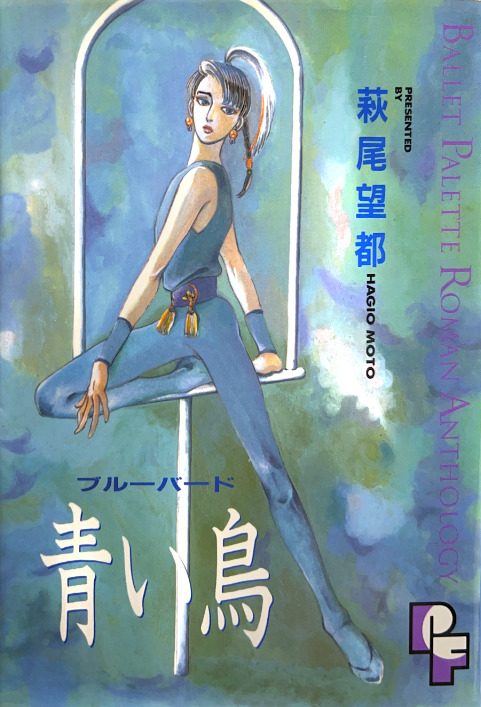
Excuse me, but I need this color illustration in my life.
Today, we proudly present you a ballet one shot from Hagio Moto, Bluebird (Aoi Tori, 青い鳥(ブルーバード)). This beautiful story was first published in 1989 November issue of Petit Flower.
DDL MangaDex
Special thanks to shielshi for being our Bluebird and making all Seldom releases possible <3
128 notes
·
View notes
Text


Interview with Shinohara Chie from the August 1987 issue of Puff
4 notes
·
View notes
Text
Absolute Cinema: Takemiya Keiko's Yoru wa Chinmoku no Toki (1978)

On this fine Saturday, we proudly bring you an amazing philosophical SF work by Takemiya: When the Night is Silent (1978).
Feast your eyes on this glorious double spread:

Thank @plats-chat's BW coins and the Vienna choir boys that broke Takemiya during that one European trip.
DDL MangaDex
78 notes
·
View notes
Text

Thank you, Takemiya sensei. I was in dire need of a cute knife sheath.
4 notes
·
View notes
Text
Cats and milk and Ooshima
This time, I got an @ from @royalgardensnake, and saw this cute little "illustrated poem" by Ooshima Yumiko that @jariten posted. It's like a little bonus to Star of Cottonland. Thanks to the Seldom crew, we bring you 4 pages of cuteness. As always, have DDL and MangaDex available for a wider reach.




ilu:

Apparently, this has a part II! So, if anyone has LaLa's 1981 April issue, please let us know!

49 notes
·
View notes
Text
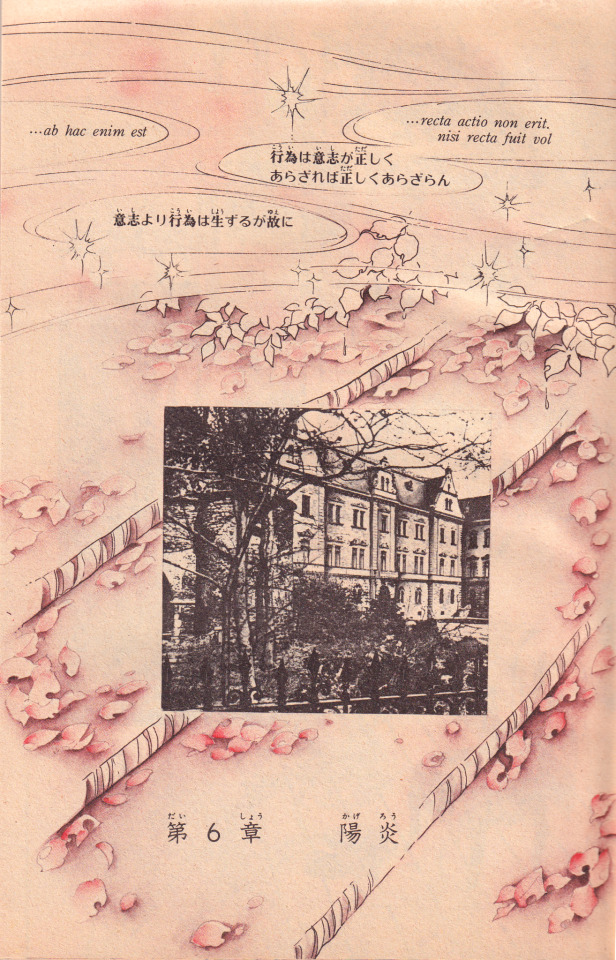







Colour pages featured at the beginning of the 6th chapter of Kaze to Ki no Uta - published in issue no. 6 of Shoujo Comic (1978)
83 notes
·
View notes
Text
That's me! I'm still looking so everyone please tell the nearest ajummas to look in the cellar for their old comics.

Help a bro out. Help a fandom out. We NEED the Korean yuri Kazeki.
143 notes
·
View notes
Text
Hatsu Akiko from June: Daybreak City Blues (1982)

When I see a wild Hatsu Akiko appearance in June, I feel obligated to let more people know.
This little, dramatic work was first published in issue #4 of June in 1982, and was later compiled in B-Kyuu Paradise! (B級パラダイス, 1985). The said compilation book with Daybreak City Blues in it was later digitalized (with some additions), and can be found on Japanese e-book retailers.
But of course, the non-grayscaled, color version @bishonenspit gracefully provided us with is much nicer.
Enjoy handsome Hatsu men in suits.
DDL MangaDex
43 notes
·
View notes
Text


Interview with Yamada Mineko from the September 1987 issue of Puff
1 note
·
View note
